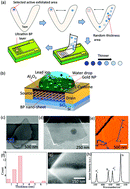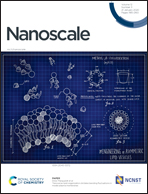Sensitive field-effect transistor sensors with atomically thin black phosphorus nanosheets†
Abstract
Atomically thin black phosphorus (BP) field-effect transistors have excellent potential for sensing applications. However, commercial scaling of PFET sensors is still in the early stage due to various technical challenges, such as tedious fabrication, low response% caused by rapid oxidation, non-ideal response output (spike/bidirectional), and large device variation due to poor control over layer thickness among devices. Attempts have been made to address these issues. First, a theoretical model for response% dependence on the number of layers is developed to show the role of atomically thin BP for better responses. A position-tracked, selected-area-exfoliation method has been developed to rapidly produce thin BP layers with a narrow distribution (∼1–7 layers), which can harness excellent gate control over the PFET channel. The typical current on/off ratio is in the range of ∼300–500. The cysteine-modified Al2O3-gated PFET sensors show high responses (∼30–900%) toward a wide detection range (∼1–400 ppb) of lead ions in water with a typical response time of ∼10–30 s. A strategy to minimize device variation is proposed by correlating PFETs’ on/off ratio with sensitivity parameters. The thickness variation of the gate oxide is investigated to explain non-ideal and ideal response transient kinetics.

- This article is part of the themed collection: Nanoscale 10th Anniversary Special Issue


 Please wait while we load your content...
Please wait while we load your content...
